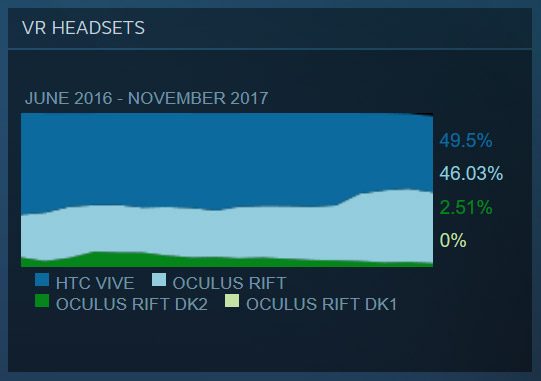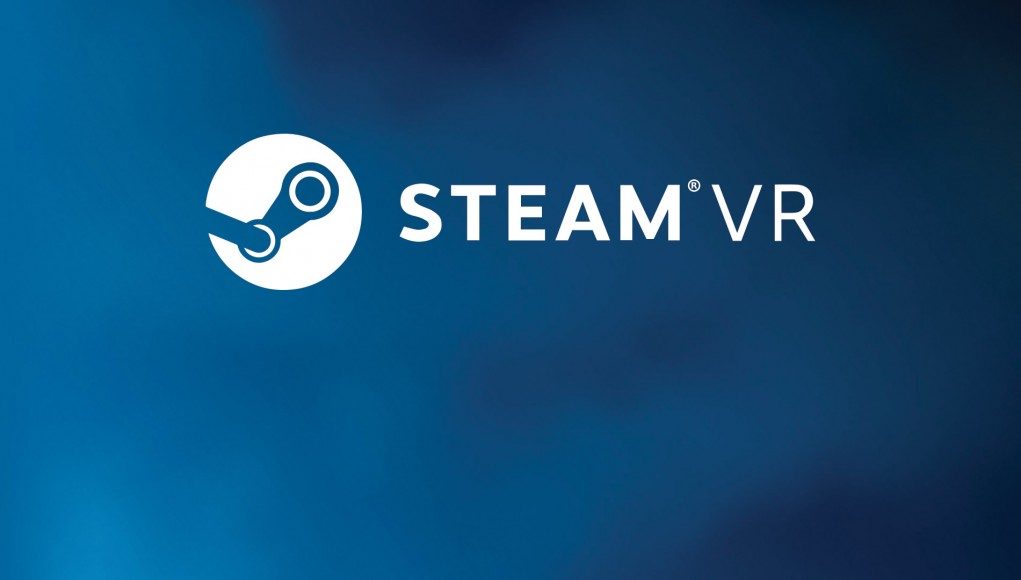According to the just-released November figures from Steam’s Hardware & Software Survey, the HTC Vive has scraped its way back from nearly losing the majority market share of VR headsets in use on Steam last month, finally ending a months long streak of Rift marketshare gains on the platform. For the first time we’re also beginning to see what appears to be the Windows VR headsets moving the needle on Steam.
Steam is the de facto content platform for the HTC Vive, though it technically supports the Rift too; plenty of Rifters use both the official Oculus Home platform and Steam to play content which may not be available on the opposing platform.
Each month, Valve runs a survey among Steam users to determine some baseline statistics about what kind of hardware and software is used by the user population, and to see how things are changing over time; that includes which VR headsets are connected to users’ computers. Participation in the survey is optional.
The latest results for the month of November show the Vive gaining 0.7% marketshare, which, combined with Rift’s loss of 1.6%, shows the headset backing away from the brink of losing its majority hold on the platform. With Steam as its primary content platform, the Vive holds onto its lead against the Rift, making up 49.5% of all VR headsets in use on the platform.
 The Rift DK2 development kit also gave up 0.8% share compared to the month prior, making way for greater share of other headsets. The DK2, which launched in 2014, still holds 2.5% of the total share of VR headsets in use on Steam. Combined, the consumer Rift and the Rift DK2 hold 48.5% of the Steam VR headset share, down from 50.9% the month prior.
The Rift DK2 development kit also gave up 0.8% share compared to the month prior, making way for greater share of other headsets. The DK2, which launched in 2014, still holds 2.5% of the total share of VR headsets in use on Steam. Combined, the consumer Rift and the Rift DK2 hold 48.5% of the Steam VR headset share, down from 50.9% the month prior.
Exactly how many Rift users use Steam among the total population of Rift users is unknown, making it largely futile to extrapolate the data in an effort to determine headset market share across all platforms. Many analyst estimates put the Vive ahead of the Rift in total sales, though in the consumer space, Oculus’ aggressive price cutting has allowed the headset to gain significant ground over the course of the last few months. Oculus also recently introduced an ‘Oculus for Business’ package, attempting to capture some of the commercial market where Vive appears to have a strong hold.
Though it seems to have been a strong sales season for VR headsets—with reduces prices and bundles aplenty—Black Friday and Cyber Monday fall toward the end of November; with shipping time (and some headsets likely remaining in their boxes as holiday gifts), we won’t likely see the true impact of the sales season on Steam’s figures until December’s data is published.
The latest figures could mean several things beyond just more headsets in the hands of new users hands: A portion of the gains may have been made up not only by new headsets entering the market, but could have come from existing Vive owners using their headsets more, and/or existing Rift users using their headsets less (potentially driven by anticipated game launches or lack thereof).
The latest figures also report a 0.02% reduction in overall VR headset use when compared to the entire Steam population, though given that we know that Oculus and HTC are still selling headsets, the most likely explanation seems to be that the rate of new non-VR users joining/using Steam is outpacing the rate of new VR users joining the service.
While the Rift and Vive vie for the top spot on Steam, a new set of headsets has entered the fray. For the first time on the VR Headsets graph on the Steam Hardware & Software survey, we’re seeing a tiny black part at the top right of the plot representing headsets other than the Vive or Rifts. The logical conclusion is that this segment, though not defined in the key, represents the Windows VR headsets which just this month got access to a SteamVR preview allowing them to tap into content on the platform.
Though not aren’t specified on the graph, we can see that the missing portion makes up 2% of the total, showing a small start for the Windows VR headsets on Steam. The share of Windows VR headsets on the platform is likely to grow more substantially once the ‘Windows Mixed Reality for SteamVR’ module leaves early access and becomes better publicized. Eventually Valve may update their data reporting to segment out each of those headsets instead of grouping them into the unknown set.







